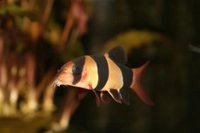| Data Sheet | ||
| Scientific Name: | Botia macracanthus | |
| Family: | Cobitidae | |
| Origin: | Indoesia | |
| Adult Size: | 10 inch / (25cm). | |
| Social: | Peaceful schooling fish | |
| Lifespan: | 50+ years | |
| Tank Level: | Mid, bottom Dweller | |
| Minimum Tank Size: | 20 gallons | |
| Diet: | Omnivore, eats most food, but prefer live food. | |
| Breeding: | Egglayer | |
| Care: | Intermediate | |
| Ideal pH: | 7.2-7.5 | |
| Temperature: | 77-86 F (25-30 C) | |
| Tank setup: | Some plants and clear area for open swimming. Rocks for hiding when shy. | |
| Sexing: | Males can be identified by the tail, which is larger and hooks inward rather than pointing straight out from the body. Females are smaller and more slender. | |
Description:The body of the clown loach is moderately elongated and laterally compressed. It has an arched back, an almost straight belly profile, and four pairs of barbels. The barbels located on the lower jaw are very small. The head is large and the mouth faces downward, with thick fleshy lips. The clown loach has an orange and black striped body, with the strips pattern being highly similar to the tiger barb.Unlike the tiger barb which tends to be highly aggressive, the clown loach is highly peaceful. Its beautiful striped body, red fins and active behavior has made it one of the most popular loaches. The pectoral, ventral, and caudal fins are yellowish with black markings.Unlike many loaches who are only active at night, the clown loach is very active during the daytime hours. Habitat/Care:Peaceful with its own and other species, it prefers to have companions with which it will form a school. It do best in groups of 3-4 or more, and having more campanions will greatly help to ensure its survival. It is a relatively slow feeder, and care must be taken to ensure that it has food to eat, especially when mixed with faster feeders such as danios. Rocks and roots suitably placed in the tank will provide shelter. A good tank setup for a Clown Loach should include ample shade, plants (plastic or real), hiding places and other peaceful fishes. Make sure the environment is not too bright. Provide shade from tank lighting. Water quality is critical for keeping clown loaches healthy. Care should be take to keep water very clean, well aerated, and warm. Mixing with other fishes:Because Clown Loaches come from rivers and streams, they are accustomed to having other fishes and plants in their environment. Not having plants and/or other fishes can cause Clown Loaches to become stressed and to go into hiding. Despite their large size, these peaceful fish can be mixed with smaller peaceful fish such as neon, cardinal or rummynose tetra. Some people have noted that the larger clown loach does prey on smaller fish especially when they are sexually active and mating (see breeding below). Diet:The clown loach requires green fod in their diet, such as scalded letuce or boiled garden peas. They are partial to chopped shrimp, cod roe, tubifex and bloodworms.. but they tend to prefer live foods.. especially worms such as tubifex or bloodworms. They are also found to make clicking noises when excited or eating. | |
Breeding:Clown loaches have to be quite old and at least 7 inches (17 cm) before they are sexually matured. It has been noted that a few weeks before spawning, the clown loaches will change their behaviour and start eating live fish as their only accepted food. The females will grow very fast on this diet, and will be almost doubled in girth by the time of spawning. On the night in which the spawning took place, the clowns loaches will swim entwined in each other and making clicking sounds. Some records have indicted that the female loach can lay as many as 500 eggs in one spawning. Clown loaches, like most other fishes, do eat their own eggs, so it is recommended that the parents be removed at this time. The fry should be fed liquid fry food for the first two weeks, after which they may accepted crushed flakes. Frys grow relatively fast, to 2.5 cm/ 1 inch in 6 weeks. After that the growth rate slowed down. Illness:Loaches are particularly prone to ick infestations, and the clown loach is no exception. The clown loach should be watched closely whenever new fish or plants are added to the tank. In the event that the fish is infected, do remember that loaches, like catfish, are very sensitive to some medications - often the dosages should be half of what is recommended. . | |
Photo Galley
Got a photo? Contact me.
 |  |  |
References Cited:
1. Shirlie Sharpe, Clown Loach [Online], Available http://freshaquarium.about.com/cs/loaches1/p/clownloach.htm
2. David Goodwin (2001), The Aquarium Fish Handbook, D & S books, England.
3. Loaches Online, Clown Loach (Botia macracanthus), [Online], Available, http://www.loaches.com/species_pages/botia_macracanthus.html
4. Clown Loach, Wikipedia - the free encyclopedia, [Online], Available,
http://en.wikipedia.org/wiki/Clown_loach



















